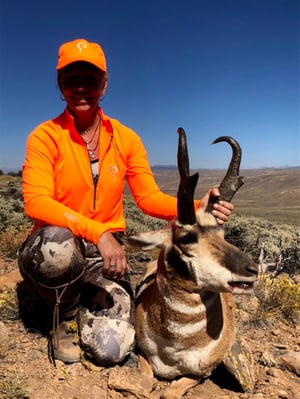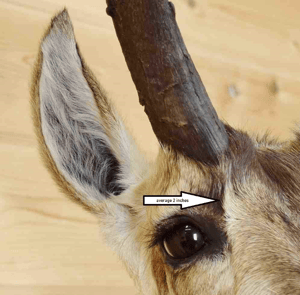Antelope hunting is just such fun. It is an action-packed hunt that can last throughout the day, as pronghorn are typically on the move all day. That said, it can be difficult to field judge these prairie critters.

It’s impossible to think you can glass a buck and size him up with a Boone and Crockett Club Score, but following a few simple tips, you can get an idea if the buck you are pursuing is the one you want. When it comes to estimating pronghorns in the field, a quick look at the overall length of the horn, the mass of the horn, and the length of the prong can give you an idea of the caliber of buck in your sights.
Horn Length
The average length of an antelope’s ear is 5 ½-inches. Use that measurement as a quick estimation of horn length. Two ears = 11-inch horn. Two and a half ears = 13 ¾-inch horn. Three ears = 16 ½-inch horn. And, anything you can visibly see is longer than three ears you know is quality. Should you be pursuing a Boone and Crockett trophy, you will want to see the length of both horns 16-inches or longer.
Please note: most pronghorn horns are curved so do your best to factor this into your estimate.
 Horn Mass
Horn Mass
The average width of an antelope’s eye is 2-inches. Using this measurement, compare the width of the eye to the base of the horn. It is safe to assume that if the base of the horn is 2-inches (the width of the animal's eye) then the circumference of that horn will be approximately 5-inches. Five inches is a fine animal, but if you are looking for a Boone and Crockett pronghorn, you will want to see the width of the base to be closer to the 7-inch mark. This measurement gives you an easy estimate to determine if the animal you have in your glass is the animal you want.
Length of Prong
This measurement is certainly a bit more subjective but can help guide you in identifying that trophy antelope. If a prong appears to be 3 ½ inches long, it is safe to bet that the overall measurement will be longer than 5-inches (as official scoring measures the prong from the back of the horn). You can use the 2-inch eye width to help gauge this estimation. If you are in search of a Boone and Crockett pronghorn, you will want the prong to be 3 ½-inches or more.
As mentioned, these tips are simple, quick tips to determine estimated measurements and are in no way a guarantee of Boone & Crockett scoring at the end of the day. I also suggest practicing these measurement techniques while you are scouting so you can have a better feel for it once the season opens.
